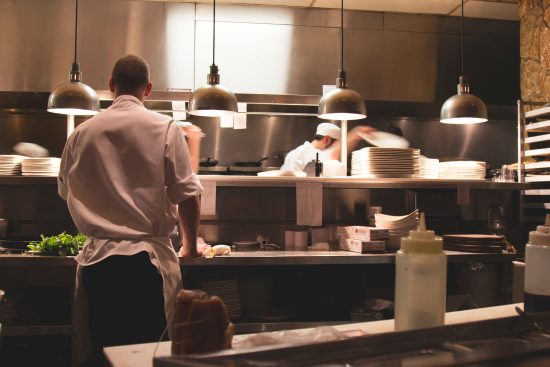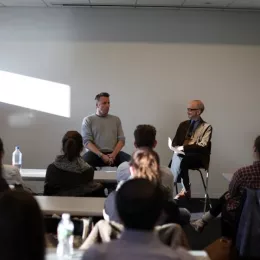A crying waitress sprinted past me to the bathroom. She was relatively new. As I later learned, a floor manager had made advances toward her in the walk-in refrigerator — and it wasn’t the first time. No was not an option, she explained to me. If she failed to succumb, her schedule suffered and her income dropped.
Eventually, the waitress quit. The damages were both personal — she was threatened, demeaned and harassed — and professional, as her experience both ended her career at that restaurant and negatively impacted staff morale. Co-workers were angry and a potential rising star was gone.

This incident occurred more than 25 years ago, in the days before most companies had defined sexual harassment policies. In those days, it was one of the occupational hazards of working in the restaurant world. Not uncommonly, you cooked in a snake pit kitchen and served in a smoke-filled dining room jungle. Has much changed since?
Not an easy question to answer. For one thing, there is no more smoking in the dining room. But as far as kitchen culture, there is still a smoking gun of indiscretion.
Despite the reality of more women working as chefs and in management, many women unfortunately still face an overly permissive work environment, with flexible rules and free-wheeling attitudes — far from the typical controlled cubicle forest with Poland water coolers and Keurig coffee makers.
Today, most mid-sized and larger companies have scrupulously designed harassment policies drafted by experienced labor lawyers. Smaller mom-and-pop shops and privately owned cafes — the bulk of restaurants —don’t have the same resources at their fingertips. But even an elaborated policy doesn’t always translate to action and therein lies part of the problem. Transgressions occur, but tacit acceptance of impermissible behavior trumps the written rules.
The food industry has implicitly upheld a code of silence. According to the Equal Employment Opportunity Commission, there are more sexual harassment claims filed in the restaurant industry than any other industry. A 2014 study showed that 66% of female and more than half of male restaurant employees reported having been sexually harassed by managers, and that 80% of women and 70% of men working in the restaurant industry reported sexual harassment by co-workers. And this doesn’t include harassment from customers who interpret table-side friendliness as more than just that.
Considering the scale of our problem — there are millions of people working in our industry — and the fact that only a fraction of claims are ever reported, the magnitude of the issue is alarming, to say the least. When Anthony Bourdain penned “Kitchen Confidential” more than a decade ago, we were all amused and only a little surprised by the sex, drugs and rock-and-roll mentality of the restaurant world. Then appeared a series of explosive restaurant reality TV shows displaying the Paleolithic fire and organized frenzy of kitchens.
Most viewers smiled, found it entertaining and wanted to see more. We failed to notice that this media portrayal, as luscious as it was, glossed over a far seedier reality. The dirty little secret of harassment — a small step past the yelling and intimidation that we loved — was lying just under the surface. What’s more, it was often the norm in high-profile operations. The harassment volcano, however, is erupting.
The lava flow of incidents and accusations has begun to incinerate an assortment of celebrated culinary industry names and wannabes. In the last few months, award-winning, well-known chefs and restaurateurs John Besh, Mario Batali, Todd English, Ken Friedman and Johnny Luzzini were accused of participating in, permitting and even fostering an environment of aggressive sexual behavior in their restaurants. I am 1000% sure that there are dozens and dozens of chefs, managers and owners who won’t be sleeping any time soon as they wait for the epidemic of harassment claims to arrive at their doors.
So how do we begin to confront the problems that run rampant in the restaurant industry? The indiscretions themselves are bad, but the issue is just as much the code of silence. If every company had a see something, say something, do something attitude, wouldn’t this help? Are we scared of repercussions or retaliation? Are we hesitant because of unclear intent or degree of infringement? Or are we simply apathetic and don’t want to make a big deal out of it or get involved?
The remedy to this pandemic begins with communication, enforcement and, ultimately the most important, culture. And this starts from the top. It is the owner, CEO, general manager or chef who sets the work culture — the day-to-day behavioral norms that govern how employees act and perform their jobs. The second most important factor is the emphasis placed on compliance.
Often, it’s the smallest, most trivial seeming issue that can create the biggest ripple effect of problems. That’s why strict compliance with a company’s sexual harassment policy is crucial. How do we talk to each other in the heat of the dinner rush? How can a harmless touch be misinterpreted? Do we realize jokes can have misunderstanding attached? Do we create a positive work environment? All of these questions must be taken seriously.
It is the owner, CEO, general manager or chef who sets the work culture — the day-to-day behavioral norms that govern how employees act and perform their jobs.
Moreover, every business should have a clear harassment policy, written in a tone and style that everyone can understand. At staff employee meetings, it must be proactively communicated and even role played if necessary. There must be a clear set of paths to report violations — whether it’s a toll-free phone number to call or text to a third party; a designated on site person or manager; or even, at the very least, an anonymous internal comment box to mention that a problem exists.
We know that often there are three sides to a story, and sadly, some accusations arise for other motives and are not always true. There are no perfect systems and no perfect industries. But, in a business like ours where people of all races, nationalities, backgrounds, sexual preferences and ages spend long hours working in a high pressure environment, selling a pleasurable experience sometimes fueled by alcohol, boundaries can blur and situations arise. In the end, a positive culture with a zero-tolerance policy and proactive procedures will go a long way to reducing this problem.
And starting to remedy the sexual harassment problem can be the start of better times in our industry. As for the waitress from 25 years ago, maybe a defined policy with clear paths of reporting would still not have saved her. Behavioral norms often are a reflection of the times in which they occur. But for all who incur similar situations in the future, I’m hoping there is a light of optimism at the end of the tunnel.
On Monday, January 22 at 10:00am, Stephen Zagor will be moderating a Sexual Harassment panel at ICE. The panel will feature leaders from the hospitality industry as well as labor issue specialists, including Susan Spikes, Executive Vice President of Operations at Hill Country Hospitality, Kutina Ruhumbika, HR Director of Barteca, labor attorney Carolyn Richmond, Elizabeth Ortiz, Director of Talent and Culture for Sofitel Luxury Hotels and Resorts, and Psychotherapist and Executive Coach Jonathan Albert. To register, email Stephen at szagor@ice.edu and include your name, phone number and the number of seats desired.
Interested in studying with Stephen? Click here to learn more about ICE’s Restaurant & Culinary Management program.




